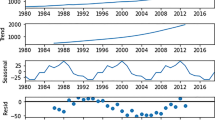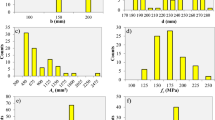Abstract
Steel is an essential raw material for various industrial and economic activities in any country. The products of the steel industry also play a significant role in the prosperity and development of society. India is the second-largest producer of steel and one of its largest consumers globally. As a result, this sector plays a vital role in the rapid development of the Indian economy. Studying the previous consumption pattern becomes crucial to understand the growth of steel demand, which will help estimate the future demand trends in this sector. The main objective of this research paper is to develop an accurate model for forecasting steel consumption in India using artificial neural networks. For creating this model, the current study considered multiple input parameters that can influence the country’s steel consumption. The data used in this research are obtained from the websites of various Indian ministries and steel associations. The quarterly data were used to train the developed model, and its performance was measured using various statistical tools. Calculations revealed that the ANN model with two hidden layers has priority over other models.





Similar content being viewed by others
Data and Materials Availability
The datasets generated and/or analyzed during the current study are not publicly available as it is part of an ongoing academic research and will be published along with thesis but datasets are available from the corresponding author on reasonable request.
Abbreviations
- ANN:
-
Artificial Neural network
- IoU:
-
Intensity of Use
- GDP:
-
Gross domestic product
- IIP:
-
Index of industrial production
- GVA:
-
Gross value added
- MSE:
-
Mean square error
- MAPE:
-
Mean absolute percentage error
- RBF:
-
Radial basis function
- MoSPI:
-
Ministry of statistics and Programme implementation
- GoI:
-
Government of India
- Trainlm:
-
Levenberg–Marquardt Algorithm
- Trainrp:
-
Resilient backpropagation
- Traincgb:
-
Conjugate Gradient
- Trainbr:
-
Bayesian regularization
- EFA:
-
Exploratory factor analysis
- CFA:
-
Confirmatory factor analysis
References
A. Azadeh, S.F. Ghaderi, S. Sohrabkhani, A simulated-based neural network algorithm for forecasting electrical energy consumption in Iran. Energy Policy 36(7), 2637–2644 (2008)
CEIC (2020) Cement production India. Retrieved from www.ceicdata.com
D.M. de Oliveira, A.L. de Oliveira Andrade, C.N. Nobre, L.E. Zarate (2009). The usage of artificial neural networks in the classification and forecast of potable water consumption. in International Joint Conference on Neural Networks
V. Dhar, R. Stein, Intelligent decision support methods: the science of knowledge work (Prentice-Hall Inc., Hoboken, 1997)
M. Evans, Steel consumption and economic activity in the UK: the integration and cointegration debate. Resour. Policy 36(2), 97–106 (2011)
Z. Gao, Y. Wang, The decomposition analysis of change of energy consumption for production in China. Stat. Res. 4(3), 52–57 (2007)
S. Ghosh, Steel consumption and economic growth: evidence from India. Resour. Policy 31(1), 7–11 (2006)
Government of India (2020) GDP Data. Retrieved from www.data.gov.in
D. Humphreys, The great metals boom: a retrospective. Resour. Policy 35(1), 1–13 (2010)
M. Humphreys, J.D. Sachs, J.E. Stiglitz, G. Soros, Escaping the resource curse (Columbia University Press, 2007)
S. Labson, P. Gooday, A. Manson (1995) China Steel. China’s Emerging Steel Industry and its Impact on the World Iron Ore and Steel Market. Canberra: ABARE Research Report 95.4
W. Linda, Trends and developments in long-term steel demand–the intensity-of-use hypothesis revisited. Resour. Policy 39, 134–143 (2014)
S. Makridakis, Accuracy measures: theoretical and practical concerns. Int. J. Forecast. 9(4), 527–529 (1993)
Ministry of Home Affairs (2021) Retrieved from http://www.mha.gov.in
Ministry of Statistics & Programme Implementation (2018) Statistical Year Book India. Government of India. Retrieved from https://mospi.gov.in/publication/statistical-year-book-india
Ministry of Steel (2017) National Steel Policy. Government of India. Retrieved from https://steel.gov.in/national-steel-policy-nsp-2017
Ministry of Steel (2021) Annual Report. Retrieved from https://steel.gov.in/annual-reports
A. Olsson, Trends and developments in the intensity of steel use: an econometric analysis (Curran Associates Inc., New York, 2008)
P. Paul, P. Mitra, Revisiting Economic Growth and Steel Consumption: evidence from India. Indian Econ. J. (2022). https://doi.org/10.1177/00194662221137264
A. Richard, Materials intensity of GDP: research issues on the measurement and explanation of the change. Resour. Policy 11, 275–283 (1985)
B. Rebiasz, Polish steel consumption. Resour. Policy 31(1), 37–49 (2006)
M.C. Roberts, Predicting metal consumption: the case of US steel. Resour. Policy 16(1), 56–73 (1990)
M. Tcha, G. Takashina, Is world metal consumption in disarray? Resour. Policy 28(1–2), 61–74 (2002)
G.K. Tso, K.K. Yau, Predicting electricity energy consumption: a comparison of regression analysis, decision tree and neural networks. Energy 32(9), 1761–1768 (2007)
P. Wang, W. Li, S. Kara, Cradle-to-cradle modelling of the future steel flow in China. Resour. Conserv. Recycl. (2017). https://doi.org/10.1016/j.resconrec.2015.07.009
S. Wang, C. Fang, X. Guan, B. Pang, H. Ma, Urbanization, energy consumption, and carbon dioxide emissions in China: a panel data analysis of China’s provinces. Appl. Energy 136, 738–749 (2015)
World Steel Association. (2021). Steel Statistics. Retrieved from https://worldsteel.org/steel-topics/statistics/
Z.L. Liu, G.Q. Pu, Y.R. Shi, J.M. Yan, X. Li, Study on MSAD-based prediction of steel production. Energy Procedia 16(131), 136 (2012)
D.P. Zhan, H. Zhang, Z. Jiang (2010). Prediction model of magnesium powder consumption during hot metal pre-desulfurization. China Metallurgy
Acknowledgements
The author is thankful to the respondents of the survey and executives of the Indian industries who helped in getting the responses.
Funding
Current research received no specific grant from any funding agency in the public, commercial, or not-for-profit sectors.
Author information
Authors and Affiliations
Corresponding author
Ethics declarations
Conflict of interest
The authors declare no conflict of interest. The affiliating institute had no role in the design of the study; in the collection, analyses, or interpretation of data; in the writing of the manuscript, or in the decision to publish the results.
Consent for Publication
The submitted work has not been published previously somewhere else. The authors have not submitted their work to two or more places, simultaneously. Also, the paper has not been published in any other languages before.
Additional information
Publisher's Note
Springer Nature remains neutral with regard to jurisdictional claims in published maps and institutional affiliations.
Rights and permissions
Springer Nature or its licensor (e.g. a society or other partner) holds exclusive rights to this article under a publishing agreement with the author(s) or other rightsholder(s); author self-archiving of the accepted manuscript version of this article is solely governed by the terms of such publishing agreement and applicable law.
About this article
Cite this article
Kumar, V., Kumar, R. Development of Artificial Neural Network Model for Indian Steel Consumption Forecast. J. Inst. Eng. India Ser. D 105, 323–331 (2024). https://doi.org/10.1007/s40033-023-00482-x
Received:
Accepted:
Published:
Issue Date:
DOI: https://doi.org/10.1007/s40033-023-00482-x




